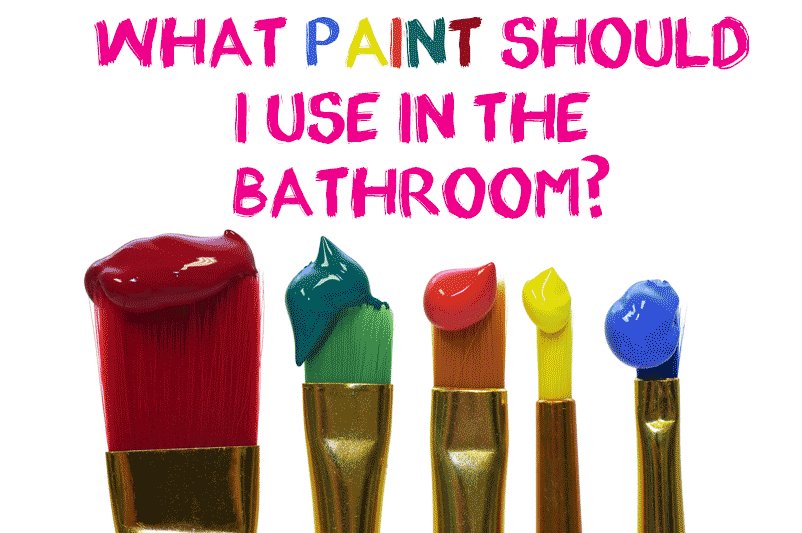What Paint Should I Use in the Bathroom?

Painting your bathroom is a little different than painting other rooms in your home. Bathrooms obviously have a lot of moisture in them, so you'll need to use a paint that can withstand persistent moisture every day of the year. That's where bathroom paint comes in, which is paint that's designed for use in bathrooms only.
However, if you're going to your local DIY shop and looking for a section called 'bathroom paint' then it may be hard to find what you're looking for. That's because the term 'bathroom paint' doesn't really exist, although some manufacturers may still use the term to reassure you that the paint is suitable for use in the bathroom. Instead, you're looking for a paint that has properties in it that's suitable for use in bathrooms. That doesn't mean the paint can't be used in your living room too, it just means that it's paint that's capable of surviving in a wet bathroom environment.
What are the properties of paint suitable for bathrooms?
You're really looking for two things that make a great paint for a bathroom. Mildew-inhibitors are the first thing to look for, which is paint that includes anti-microbial additives that are capable of stopping mildew from forming. However, it's important to be aware that it won't completely avoid this from happening, it's just less likely.
The other property you're looking for is paint that has a tighter structure and a tougher finish. This means you can wipe it down without causing damage to the paint, as long as you're not using non-abrasive cleaners. It also allows for the use of flat or matte finishes, although I'll come back to these types of paint later.
Because a lot of ordinary house paint now has these properties, there is no real need for anything called bathroom paint these days.
Tackling mould and mildew head-on
While many paints profess to be 'mould and mildew' resistant, what this actually means is that they only help slow its formation. If your walls are constantly wet then all the mould resistant paint in the world won't stop it from eventually forming. Instead, it's better to tackle the problem head-on and, in theory, try to prevent moisture from collecting on surfaces in the first place.
Here are a few ways to mitigate moisture on bathroom walls:
- Install an extractor fan, or at least keep the bathroom well ventilated by opening a window.
- Ensure you clean painted surfaces regularly, especially if you notice mould developing.
- Try to avoid water splashing on painted surfaces. This is easier said than done in a bathroom, but ensuring you have watertight shower curtains/shower doors, backsplashes and tiled surfaces around baths or showers will go a long way to prevent water from collecting on painted surfaces.
The key word here is 'mitigation'. You're never going to prevent moisture on your bathroom walls (unless you stop using your bathroom altogether) but you can take steps to ensure that only a little moisture collects.
Read this article for more tips on preventing moisture and condensation in the bathroom.
So, what paint is not going to be ruined after a few months and will help protect your walls from growing mouldy? Let's go over a few.
Types of paint and how they cope in a bathroom
The type of paint you'll choose for your bathroom depends on how well ventilated your bathroom is. For example, if your bathroom doesn't suffer from a lot of condensation build-up then you can choose a paint that is less resistant than others. On the other hand, a bathroom with poor ventilation would be better off with a paint that has high water-resistant. Personally, I would always go for the highest water-resistant paint anyway, but the cost may also be a factor you need to consider.
Let's take a look at the types of paint available on the market and find out how useful they are in a bathroom setting:
- Flat or eggshell paints: Flat paint gives a nice matte finish, while eggshell has more of a sheen and tends to be more washable than flat paints. These generally aren't suitable for use in bathrooms, as they tend to absorb moisture. However, there are now some premium flat and eggshell paints on the market that are made to be suitable for bathrooms. Expect to pay a premium price for these kinds of paint. Always check the can to see if it says 'suitable for use in bathrooms'.
- Satin paint: With a slightly glossy finish, satin paint can be used in bathrooms with low moisture due to good ventilation. A good example would be a downstairs toilet.
- Semi-gloss paint: With a high sheen that provides an eye-catching finish, semi-gloss paint is perfect for use in the bathroom. It's excellent at repelling moisture.
- High-gloss paint: High-gloss paint is the best paint to use in the bathroom due to it being incredibly moisture repellent. High-gloss was used the most in bathrooms in the past due to this, but now that regular paints include moisture resistant properties, it's largely fallen out of favour. This is due to the fact that high-gloss tends to look pretty dire on large wall surfaces as it tends to show up all the lumps and bumps in your bathroom walls. It's more suited for smaller surfaces such as trims and cabinets.
Out of all the options, semi-gloss paint is probably your best bet. However, as shown above, technically all of these types of paint can be used. It all depends on your unique bathroom, so you'll have to use your best judgement to decide which type of paint you will ultimately use in your own bathroom.
Just remember that anything that is labelled as 'bathroom paint' tends to command a higher price than normal acrylic paints on the market. Get used to checking the can of any paint you like the look of to see if it contains the properties that a wet bathroom environment requires.





